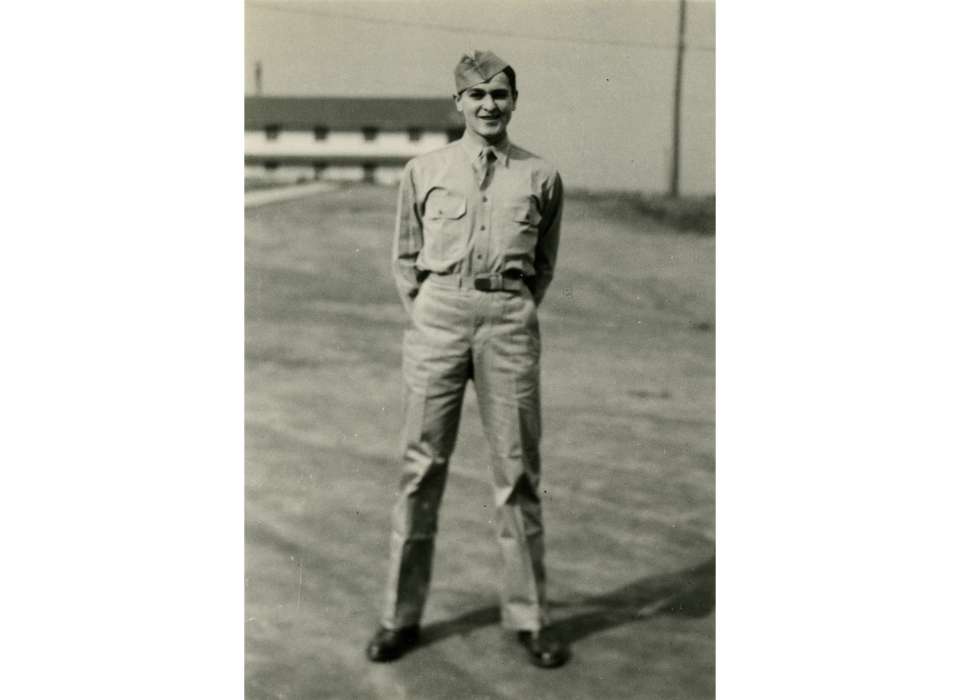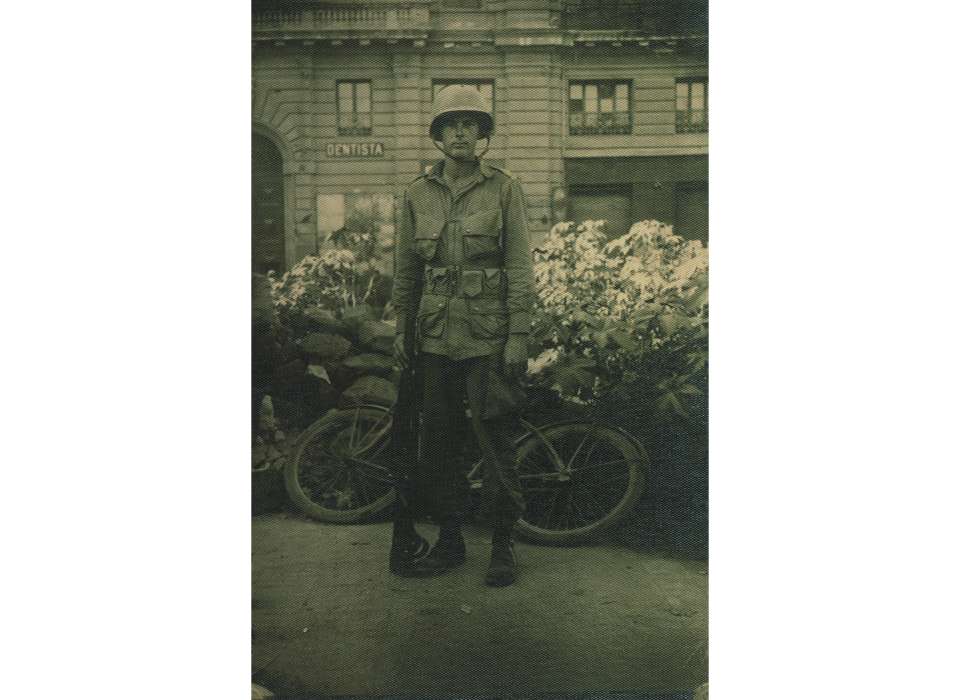Description:
The WWII Media and Education Center at The National WWII Museum has teamed with Louisiana Public Broadcasting to present the new documentary Seize & Secure: The Battle for La Fière. A component of the Museum’s extensive commemoration of the 75th anniversary of D-Day, the film—which captures “probably the bloodiest small unit struggle in the experience of American arms”—makes its broadcast premiere on June 6, 2019, on PBS.
The mortal ferocity of the four-day battle for control of the small stone bridge over the Merderet River at La Fière in Normandy is testament to the bridge’s strategic importance in the D-Day invasion of June 1944. Without control of the bridge and its vital causeway, American forces coming from Utah Beach would not have been able to force their way inland.
Fought largely by paratroopers and glidermen from the 82nd Airborne Division, the battle to secure the bridge at La Fière is described as “probably the bloodiest small unit struggle in the experience of American arms.” Victory at La Fière cost more than 250 American lives, and yet the fateful engagement’s story is largely untold.
To mark the 75th anniversary of the Normandy invasion, the WWII Media and Education Center at The National WWII Museum has teamed with Louisiana Public Broadcasting (LPB) to present a new documentary, Seize & Secure: The Battle for La Fière, to premiere on June 6, 2019, on PBS. Capturing the La Fière story for the first time in documentary form, the production calls on military historian Colonel Kevin W. Farrell, PhD—whose past credits include the 2014 WWII film Fury—and Executive Director of the Museum’s Institute for the Study of War and Democracy and Samuel Zemurray Stone Senior Historian Robert M. Citino, PhD, as on-camera analysts. The film also draws on historic and contemporary images and footage of the battle scene, as well as eyewitness accounts by WWII veterans who fought there. Mark Harmon (NCIS, The West Wing, Chicago Hope) serves as narrator.
“Beyond the operational role that La Fière played in terms of keeping the (invasion) timetable on schedule, there's another reason to study the Battle of La Fière Bridge, and that's valor,” Citino said. “This isn't just a great moment in the history of the US Army, it's a moment, I think, that should make all Americans proud. La Fière is a battle for the ages, and I'm glad to finally see it getting the attention it deserves.”
The film’s screenwriter, Charles Richard, is Co-Director of the Creative Writing Program at the University of Louisiana at Lafayette. His credits include the Louisiana Public Broadcasting documentaries Louisiana: 200 Years of Statehood and Katrina Ten Years After: A Second Life, A Second Chance. Richard’s work has earned such honors as Best Historical Documentary twice at the New York International Independent Film and Video Festival as well as a prestigious Alfred I. duPont-Columbia University Award—television’s equivalent to the Pulitzer Prize.
The score for Seize & Secure: The Battle for La Fière is by Lauren Buchter, a New York City-based composer for film and television and an ASCAP (American Society of Composers, Authors, and Publishers) Composer to Watch. Her credits include the 2018 independent feature In the Orchard and the 2016 documentary Cherry's in Season.
Bob Murphy
Bob Murphy forged his birth certificate (with the help of his father, a WWI veteran) at age 17 to join the US Army in October 1942. He fought in Italy and at 1:15 a.m. on D-Day jumped into Normandy as a Pathfinder with the 505th Parachute Infantry Regiment. On D-Day and D+1, he participated in the defense of the La Fiere bridge against two German attacks. At the peak of fighting there on D+1, Murphy was sent to the front lines as a runner to check the company’s status and report back. He was told that “A” Company of the 505th was low on men and ammunition and in danger of being overrun. Murphy took the message to Lieutenant John “Red Dog” Dolan, who in turn scribbled a note on a small piece of paper and ordered Murphy to take it back to Sergeant Billy Owen. The note read, “I know of no better spot to die. We stay.” Murphy went on to fight in the Battle of the Bulge. After the war, he finished high school and went on to become a trial lawyer. He later joined the US Army Reserve and retired as a colonel. He served two terms as national president of the 82nd Airborne Association, and jumped many times during commemorative parachute drops in Normandy.

Bud Olson
Bud Olson enlisted in the US Army and received advanced schooling in intelligence and enemy weapons while in England prior to the Normandy invasion, his first combat experience. He arrived in Normandy on June 7 by Horsa glider along with 29 men, a pilot, and a copilot. Staff Sergeant Olson never saw any of his fellow passengers again, believing that he was the only survivor of the crash who was able to continue fighting. Through the first three days of the invasion, he and 3rd Battalion, 325th Glider Infantry Regiment, were engaged in minor skirmishes. On the evening of D+2, his unit received orders to move out toward the bridge at La Fiere. With the rest of his unit, he participated on the frontal assault across the La Fiere causeway on D+3. After the attack, Olson was ordered to locate and lead the 90th Division ground troops from Utah Beach across the causeway. After the battle, Olson was ordered to lead a detail to pick up the dead soldiers that littered the area. His men refused, so he located a vat of Calvados and got them “gloriously drunk.” Olsen, a nondrinker, and his men finished the job. After the war, Olson returned home, married his sweetheart, bought a small ranch in his native Montana, and started a family. An expert on regional Native American history, Olson served as a local county commissioner for many years.

Dave Bullington
A veteran of both the Sicily and Italy campaigns with “A” Company, 1st Battalion, 505th Parachute Infantry Regiment, Dave Bullington made his third combat jump on D-Day, a perfect and dry landing near his assigned drop zone. His job at Normandy was Browning Automatic Rifleman (BAR). The BAR weighed 20 pounds empty and fired a 20-round magazine (300 rounds per minute in manual, 650 rounds per minute in full automatic) and was an extremely effective and reliable weapon against infantry. At La Fiere, he unloaded his BAR over and over at close range into the crowd of German infantry on the causeway, as he and “A” Company repelled the first and second German cross-causeway attacks on D-Day and D+1. Quiet and soft-spoken, Bullington was proud but never boastful of his notable deeds in WWII. He was one of a handful of four-jump veterans in WWII and added a fifth a decade later in Korea.

Homer Jones
A first lieutenant and rifle platoon leader for “B” Company, 1st Battalion, 508th Parachute Infantry Regiment at Normandy, Homer Jones played a key role in capturing La Fiere Manoir after taking command of “B” Company when his original company commander, Captain Royal Taylor, was wounded in the jump. On D-Day morning, Jones led “B” Company in a coordinated attack on the manoir, reaching the cellar of the main building, tossing grenades in the windows and firing his Thompson sub-machine gun up through the floorboards. In the early afternoon of D-Day, he led “B” Company across the La Fiere causeway to reinforce the 507th Parachute Infantry Regiment in establishing a bridgehead on the Cauquigny (west) side of the Merderet River marsh, but was overrun by the Germans as they attacked and secured Cauquigny. “B” Company suffered several casualties while retreating through the marsh.
.jpg)
John Marr
John Marr joined the US Army in June 1941 with the sole intention of becoming a paratrooper, becoming one of the elite. Following his graduation from jump school, John was assigned to the 507th Parachute Infantry Regiment in preparation for that unit’s attachment to the 82nd Airborne for the Normandy invasion. Like many 507 troopers, Marr found himself far off of his intended drop zone when he landed in the middle of a swamp early on the morning of June 6. Eventually locating his commanding officer, he made his way to La Fière and participated in the successful capture of the manor. Later that afternoon, Marr and his fellow G Company troopers made their way across the causeway to Cauquigny only to be forced out by oncoming German forces. Marr and his men made their way to an isolated group of paratroopers under the command of Colonel Charles Timmes. On D+2, Marr was ordered to find a way to link up with other American forces from his isolated and surrounded position. Marr and scout Norman Carter discovered a route to establish contact and get more supplies. Later that evening, Marr participated in the failed night attack on Cauquigny. Following the failed attack, he and the rest of the survivors in Timmes Orchard held their defensive positions until the battle for the causeway had been won. Following Normandy, Marr was promoted to Executive Officer of G Company, then later became commanding officer of B Company 507th. He led that unit through the Battle of the Bulge and Operation Varsity in 1945. John stayed in the Army after World War II, serving in Korea and Vietnam. During the latter conflict, he served as a full colonel, commanding the 17th Combat Aviation Group. His decorations include two Silver Stars, three Bronze Stars, the Purple Heart, two Legions of Merit, the Distinguished Flying Cross, the Distinguished Service Medal, the Army Commendation Medal, and nine Air Medals.

World Premiere
June 5
6:00 p.m. Reception | 7:00 p.m. Screening | 8:00 p.m. Q&A with filmmakers
Solomon Victory Theater
(By Invitation Only)
Broadcast Premiere
June 6 | 8:00 p.m.
WYES in New Orleans | WLPB in Baton Rouge | KLPB in Lafayette
(check your local listings for date and time)
Free Museum Encore Screening
Seize & Secure: The Battle for La Fière
Friday, June 7
5:00 p.m. Happy Hour at The American Sector Restaurant & Bar | 6:00 p.m. Screening
Solomon Victory Theater
This screening is free and open to the public but please register to attend.
Shreveport Screening
Seize & Secure: The Battle for La Fière
Friday, June 14
6:00 p.m.
617 Texas Street, Shreveport, LA 71101
